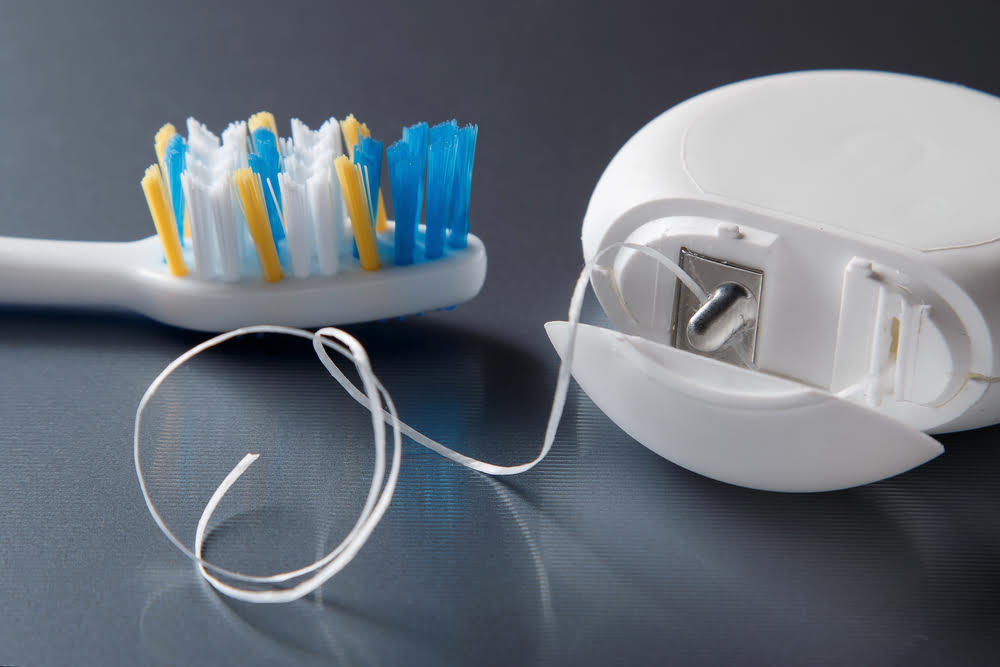Skipping flossing may seem harmless, but it can lead to serious health problems and expensive dental treatments.
Flossing is key for taking out plaque and food stuck between your teeth that your toothbrush can’t get to. When you don’t floss, you’re putting your gums and teeth at risk.
In this article, we’ll look at the hidden dangers of skipping flossing and why making it a daily routine is important for keeping a healthy, confident smile.
The Hidden Dangers of Skipping Flossing
You’re rushing through your morning routine, quickly brushing your teeth before dashing out the door.
Flossing feels like a task for when you have more time, so you skip it. But that’s a mistake.
Neglecting this essential step in your oral hygiene routine can lead to numerous hidden dangers that jeopardize your gum health and overall well-being.
The Sneaky Nature of Plaque Buildup
Plaque, the sticky, colorless film of bacteria that constantly forms on your teeth, is the primary culprit behind many dental woes. This bacterial film is relentless, releasing acid that erodes tooth enamel and irritates the delicate gum tissue.
If left unchecked, plaque can harden into tartar, a stubborn substance that can only be removed by a dental professional.
Here’s the kicker: Plaque accumulates most rapidly in the spaces between your teeth and along the gumline-precisely the areas your toothbrush can’t effectively reach.
That’s where flossing comes in as your ultimate plaque-fighting ally.
But what happens when you neglect to floss consistently?
You’re essentially rolling out the red carpet for harmful oral bacteria to thrive. These bacteria feed on the food particles and debris left behind, releasing toxins that irritate the gums and cause inflammation.
Over time, this chronic inflammation can open the door to a multitude of problems, including bad breath, tooth decay, and gum recession. And that’s just the beginning.
How Plaque Leads to Gum Disease
When you fail to remove plaque through regular flossing, you’re setting the stage for gum disease to take hold.
It starts with gingivitis, a mild form of gum inflammation characterized by redness, swelling, and bleeding.
At this stage, the damage is still reversible with proper oral hygiene habits and professional care at Farnham Dentistry.
If you continue to ignore the warning signs and let plaque and tartar accumulate unchecked, gingivitis can progress to periodontitis-a severe form of gum disease with devastating consequences.
In periodontitis, the gums begin to pull away from the teeth, creating deep pockets that harbor even more harmful bacteria.
As the infection spreads, it can destroy the supporting bone and connective tissue, leading to tooth mobility and eventual tooth loss.
The scary truth is that periodontal disease is incredibly common. The CDC reports that a staggering 47% of adults aged 30 and older have some form of periodontal disease.
But the risks don’t stop at your mouth. Numerous studies have linked gum disease to an increased risk of systemic health issues, including heart disease, stroke, diabetes, and even Alzheimer’s disease.
The bacteria responsible for gum inflammation can enter the bloodstream and contribute to chronic inflammation throughout the body.
The Shocking Costs of Treating Gum Disease
Neglecting to floss not only takes a toll on your oral health but also on your wallet.
Treating gum disease can be a costly endeavor, with expenses that can quickly add up over time.
The further gum disease progresses, the more intensive and expensive the treatments become.
If caught in the early stages, gingivitis can often be reversed with a thorough professional dental cleaning and improved at-home oral hygiene habits, including diligent flossing. However, if you let gum inflammation spiral into periodontitis, you may need to undergo more extensive and costly procedures.
Scaling and root planing, a deep cleaning treatment that removes plaque and tartar buildup below the gumline, can cost upwards of $1000 per quadrant of the mouth.
If significant gum recession has occurred, you may require gum grafting surgery to restore lost tissue and protect exposed tooth roots. This procedure can range from $600 to $3000 per tooth, depending on the extent of the damage.
But the costs don’t end there. Maintaining periodontal health after treatment often requires ongoing care, including more frequent dental cleanings every 3-4 months.
These maintenance visits can easily set you back $300 or more each time. And if you’ve experienced bone loss or tooth loss due to advanced periodontitis, you may be facing even more expensive restorative procedures, such as bone grafting and dental implants.
The Exceptional Gum Health Benefits of Flossing
If you think brushing alone is enough to maintain a healthy smile, think again.
Flossing is the unsung hero of oral hygiene, and it’s time to give it the spotlight it deserves.
By making flossing a non-negotiable part of your daily routine, you’re taking a crucial step towards optimal gum health and a lifetime of beautiful, confident smiles.
How Flossing Combats Plaque Where Brushing Can’t
Your toothbrush is a powerful tool, but it has its limitations. The bristles, no matter how advanced, are simply too thick to effectively clean the tight spaces between your teeth where plaque thrives.
This is where floss comes in, specifically designed to slide into these narrow crevices and dislodge the food particles that feed harmful plaque bacteria. But floss doesn’t just remove debris-it’s a true plaque-fighting champion.
With its unique contoured shape, floss hugs the curves of your teeth, scraping away plaque along the gumline where it poses the greatest threat. By disrupting the plaque growth cycle daily, you’re proactively protecting your gums from inflammation and infection.
Clinical Evidence for Flossing’s Gum Health Benefits
The effectiveness of flossing isn’t just a myth perpetuated by dental professionals-it’s backed by solid scientific evidence. Numerous studies have consistently demonstrated the remarkable impact of flossing on gum health.
A comprehensive 2006 review found that flossing significantly reduces gingivitis compared to brushing alone. Furthermore, a 2011 Cochrane review confirmed that the combination of flossing and brushing is substantially more effective at reducing plaque and gingivitis than brushing as a solo act.
The long-term benefits are equally impressive. A 2015 meta-analysis revealed that regular flossers maintain healthier gums and experience less bleeding over an extended period. And if you need more convincing, a 2017 study showed that flossing significantly reduced bleeding gums in as little as three to six months.
The message is clear: If you want to keep your gums in optimal condition, flossing needs to be a permanent fixture in your daily oral care routine.
The Whole Mouth Health Advantages of Flossing
While the gum health benefits of flossing are undeniable, its positive impact extends far beyond just preventing gum disease.
By targeting those hard-to-reach spaces between your teeth, flossing helps prevent cavities from developing in spots your toothbrush struggles to clean properly. This, in turn, reduces your risk of tooth decay, sensitivity, and the need for costly treatments like fillings and crowns.
Moreover, flossing plays a key role in maintaining fresh breath by removing trapped food particles before they can decompose and cause unpleasant odors.
But the advantages don’t end with your oral cavity. By reducing the overall bacterial load in your mouth, flossing may lower the risk of harmful microorganisms entering your bloodstream or being inhaled into your lungs.
Some studies suggest that maintaining good oral hygiene, including regular flossing, may contribute to a reduced risk of certain systemic health issues like heart disease, diabetes, and even dementia.
While more research is needed to fully understand these connections, one thing is certain: Flossing is a simple yet powerful habit that can have far-reaching benefits for your oral and overall health.
Proper Flossing Technique for Maximum Plaque Removal
Let’s take a closer look at the right way to floss to make sure you get the most from your daily routine.
Step-by-Step Guide to Effective Flossing Form
The key to good flossing is in the details.
Start by breaking off a long piece of floss, about 18 inches. This may seem like a lot, but using fresh floss for each tooth is vital to stop the spread of bacteria.
Wind most of the floss around your middle fingers, leaving just an inch or two to work with.
Next, pinch the floss tight between your thumbs and pointer fingers.
Keeping this tension is crucial for complete plaque removal and control as you move between teeth.
Gently guide the floss between your teeth using a zig-zag motion, taking care not to snap it into your gums, which can cause irritation.
As you reach the gum line, shape the floss around each tooth in a C-shape. This allows the floss to slide along the sides of the tooth, both above and slightly below the gum line, where plaque tends to build up.
Use a gentle back-and-forth motion to loosen debris and disrupt bacterial growth.
Remember to use a clean section of floss for each tooth gap, unspooling fresh floss as you move through your mouth.
This prevents the redistribution of plaque and bacteria.
If you find that the floss shreds or gets stuck between tighter contacts, consider switching to a waxed kind for smoother gliding.
Pro Tips and Tricks for Frustration-Free Flossing

For some people, traditional flossing can be challenging. Whether it’s due to dexterity issues, dental work, or sensitive gums, there are several tools and techniques that can make flossing easier and more effective.
If you have trouble with manual dexterity or find it hard to reach certain areas of your mouth, try using pre-threaded flosser picks or floss holders. These tools allow for easier one-handed use and can help maintain proper form, ensuring that you can effectively clean even the hardest-to-reach spots.
For those with braces, bridges, or other dental work, floss threaders are a game-changer. These flexible plastic needles let you guide the floss under and around these appliances, making sure no area is left dirty.
If you have sensitive gums or a history of gum issues, a water flosser may be a gentler yet still effective alternative to traditional string floss. These devices use a targeted stream of water to dislodge plaque and debris, making them a great choice for those with tender gums or orthodontic appliances.
What to Do If You Have Sensitive or Bleeding Gums
When you first start flossing, it’s common to have some sensitivity or bleeding, especially if your gums are inflamed from bacterial buildup. However, with regular gentle flossing, this inflammation will decrease, and the sensitivity should go away.
If you’re new to flossing or have sensitive gums, start slowly and be patient with yourself.
Focus on just a few teeth at first, gradually working up to flossing your whole mouth as your gums get used to it and become healthier.
When choosing floss, opt for a soft, flexible material like nylon or PTFE, which are less likely to bother sensitive gums while still effectively removing plaque.
Take your time and floss slowly, using gentle pressure to avoid more irritation.
It’s important to note that while some initial bleeding is normal, bleeding that keeps happening after a week of gentle daily flossing means you should visit your dentist.
This could be a sign of underlying gum issues that require professional attention.
Building a Rock-Solid Daily Flossing Habit
Making flossing an essential habit you practice daily is crucial for keeping your mouth healthy. By flossing every day, you can stop plaque and tartar from building up, lower your risk of gum disease and cavities, and have a healthier, more confident smile.
The Undeniable Power of Flossing Every Single Day
The key to getting all the benefits of flossing is doing it daily.
Plaque, the sticky coating of microbes that persistently accumulates on our teeth, starts to regrow in the spaces between teeth in just 24 hours.
When left alone, plaque can solidify into an obstinate deposit that only a dentist can remove.
By committing to floss every day, you actively interrupt the plaque buildup cycle, stopping harmful bacteria from accumulating and tartar from forming. This steady removal of plaque not only promotes healthier gums but also dramatically cuts down on bleeding gums in just 1-2 weeks of regular flossing.
Daily flossing plays an indispensable role in keeping breath fresh by removing food particles that can get trapped between your pearly whites. When these particles are allowed to sit and rot, they lead to bad odors and create the perfect environment for harmful bacteria to multiply.
Flossing daily can save you both time and money over the long haul. By preventing gum disease and cavities from developing, you minimize the need for expensive and invasive dental work later on.
Spending just a few minutes flossing each day can mean a lifetime of healthier teeth and gums, lowering your risk of more serious oral health problems.
Making Flossing a Natural Habit in Your Daily Life
Adding flossing into your daily routine may seem tough at first, but with a few simple tricks, you can make it feel automatic. The most effective way to create a steady flossing habit is to connect it to an existing daily ritual, like brushing your teeth before bed.
To reinforce this link, keep your floss in a visible spot on your bathroom counter or with your toothbrush. This visual reminder will prompt you to reach for the floss whenever you brush.
Additionally, setting a daily alert on your phone can help you stay on track until flossing becomes second nature.
To further motivate yourself, try making flossing a rewarding experience.
Use an app or calendar to track your flossing streaks and celebrate your progress.
Seeing your commitment to oral health in tangible form can provide a sense of accomplishment and push you to keep up your new habit.
An effective strategy is to make flossing a family activity.
By getting your loved ones involved in your oral health journey, you build in a support system and create accountability.
When everyone in the household is working toward the same goal, it becomes easier to stay committed and motivated.
What to Do If You Slip Up and Miss a Few Days
Despite our best plans, life can sometimes disrupt our daily routines. If you find yourself slipping up and skipping flossing for a few days, it’s key not to be too hard on yourself or give up on the habit completely.
Take a moment to refocus and gently ease back into your flossing routine. Even if your gums feel a little sensitive at first, remember that this is temporary discomfort that will fade as you reestablish your habit.
The important thing is to recommit to your oral health goals and keep the long-term benefits of steady flossing front of mind.
If you struggle to get back on track, don’t hesitate to ask your dentist or hygienist for personalized tips and encouragement. They can offer tailored advice to help you overcome any challenges and provide the support you need to make flossing an ingrained habit you practice every day.
Remember, even occasional flossing is better than no flossing at all.
Every effort you make to prioritize your oral health is a step forward. By focusing on progress rather than perfection, you can gradually build a rock-solid flossing habit that will serve you well for years.

Summing Up
Flossing is a key part of keeping your gums healthy and smile bright. Make it a daily routine to take out plaque and bacteria from between your teeth and along the gumline.
If you’re not sure about how to floss the right way, ask for help at your next dental checkup. Learning the proper flossing method will help you get the long-term benefits of good oral health.
Spending just a few minutes every day flossing can prevent expensive and uncomfortable dental problems later on. Take control of your oral health now by making a daily flossing routine.

